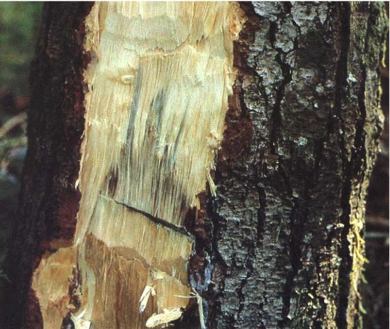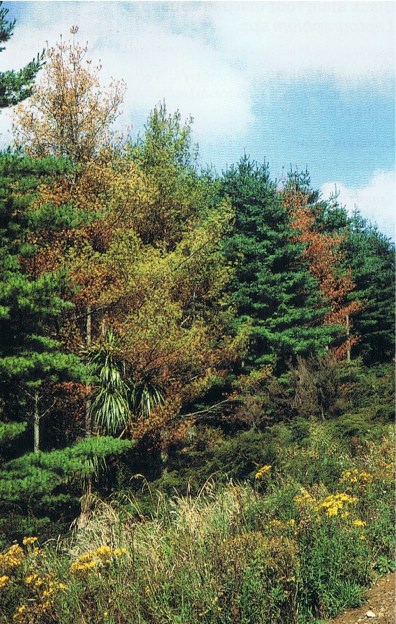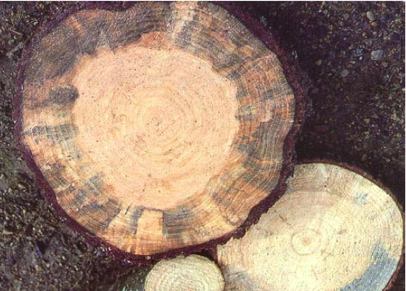PESTS AND DISEASES OF FORESTRY IN NEW ZEALAND
Leptographium root disease
Scion is the leading provider of forest-related knowledge in New Zealand
Formerly known as the Forest Research Institute, Scion has been a leader in research relating to forest health for over 50 years. The Rotorua-based Crown Research Institute continues to provide science that will protect all forests from damage caused by insect pests, pathogens and weeds. The information presented below arises from these research activities.
Forest Pathology in New Zealand No. 6
(Note: Previously known as Verticicladiella root disease. Species of Verticicladiella have now been reassigned to the genus Leptographium
Based on M. MacKenzie and M. Dick (1984). Revised 2009
Causal organisms
Leptographium alethinum K.Jacobs, M.J.Wingfield & Uzunovic
Leptographium euphyes K.Jacobs & M.J.Wingfield
Leptographium lundbergii Lagerberg & Melin = Leptographium
truncatum (M.J.Wingfield & Marasas) M.J.Wingfield
Leptographium procerum (W.B.Kendrick) M.J.Wingfield

Fig. 1 - Black stain in the wood near the base of a tree infected by Leptographium root disease.
Type of injury
Blue-black stain in the wood and death of individual trees.
Diagnostic features
- Black stain in the roots and in the wood at the base of the tree (Fig.1). The stain tends to follow the annual rings, and crescent-shaped stained regions can be seen in discs cut from near the base of infected trees.
- Heavy resin bleeding near the base of dying trees.
- Foliage light green at first, then wilting and turning rusty brown (Fig. 2).
- Tree death as a result of infection also often associated with root damage caused by the construction of roads and access tracks.

Fig. 2 - Pinus strobus in various stages of decline as a result of infection by L. procerum.

Fig. 3 - Black stain in a disc cut from a tree killed by L. procerum.
Hosts
Pinus radiata and P. strobus .
Distribution
Throughout New Zealand.
Disease development
Short-distance spread of the fungi is thought to occur when the roots of an infected host come into contact with roots of neighbouring trees. The mechanism of long-distance spread is not clearly known.
Once the fungi have gained entry they spread through the wood, producing a dark brown or black stain in the roots and in sapwood (Fig. 3). This dark stain may be quite extensive in the roots, but usually only extends a short distance up the stem from the root collar. Resin bleeding at the base of the tree is common in P. radiata. Leptographium procerum has been associated with tree death more frequently than the other species of Leptographium reported in New Zealand. Infection has been recorded only in forests on heavy clay soils prone to waterlogging, stress caused by waterlogging and root disturbance appears to be an important factor leading to death of infected trees.
Infection initially causes a reduction in shoot growth. Later, needles droop and become chlorotic, then turn rusty brown and die. In radiata pine, copious resin bleeding near the base of the tree is common. Infected trees usually die quickly, but some have been known to go into decline and persist, with thin chlorotic crowns, for up to 8 years. Dead needles remain attached to the dead tree for a year or more.
Economic importance
Species of Leptographium have been associated with death of individual Pinus radiata and P. strobus trees in many parts of New Zealand. So far, only isolated tree deaths attributable to L. procerum have been recorded.
Control
Not considered necessary.
Bibliography
Gadgil, P.D. 2005: Fungi on trees and shrubs in New Zealand. Fungi of New Zealand Volume 4. Fungal Diversity Research Series 16: 1-437
Ridley, G.S., Dick, M. 2001: An introduction to the diseases of forest and amenity trees In New Zealand. Forest Research Bulletin 220, Rotorua, New Zealand
Shaw, C.G.; Dick, M. 1980: Verticicladiella root disease of Pinus strobus in New Zealand. Plant Disease 64: 96-8.
Shaw, C.G.; Dick, M. 1984: Verticicladiella root disease. New Zealand Forest Service, Forest Pathology in New Zealand No. 6.
This information is intended for general interest only. It is not intended to be a substitute for specific specialist advice on any matter and should not be relied on for that purpose. Scion will not be liable for any direct, indirect, incidental, special, consequential or exemplary damages, loss of profits, or any other intangible losses that result from using the information provided on this site.
(Scion is the trading name of the New Zealand Forest Research Institute Limited.)

 Farm Forestry New Zealand
Farm Forestry New Zealand

